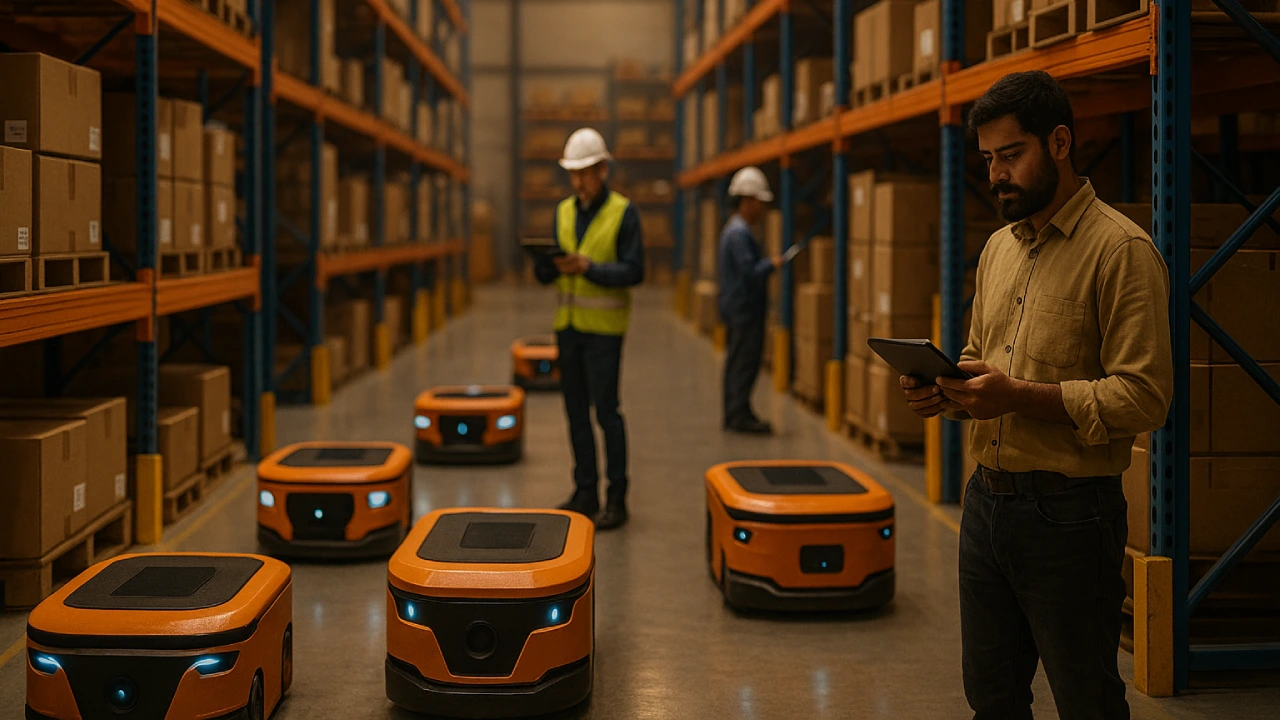Copyright techgenyz

Robots in Retail are transforming India’s warehouse operations by improving efficiency, speed, and safety through advanced automation and brilliant orchestration.Home-grown innovators like Addverb, Unbox Robotics, and GreyOrange are driving India’s warehouse automation revolution, optimizing fulfillment for e-commerce and logistics.Flexible models like Robotics-as-a-Service (RaaS) are making robots in retail accessible to MSMEs, reducing upfront costs while scaling fulfillment capacity across India. Walk into any of India’s modern retail warehouses these days, and, instead of just aisles of boxes and trolleys and people pushing them, you might see a fleet of compact robots zipping between the racks, cameras and sensors tracing inventory in real time, and software orchestrating the orders across machine and human. The shift may not be dramatic theater but relatively incremental, practical, and often invisible to the shopper. It has many of the following consequences: faster delivery options even on peak-season sales days, smaller facilities packing more capacity into the duplicate square footage, and workers who are less physically drained and taxed. This feature explores what’s driving that change in 2025, who’s leading it, and how retailers, workers, and cities are adapting. Why automation now fits India’s retail story There are multiple converging forces that make warehouse robotics an attractive opportunity for India. E-commerce continues to grow aggressively, which is pushing logistics providers to compress lead times and costs. Urban land for large distribution centers is costly; robots that stack vertically and optimize movement help to shrink the effective footprint needed to fulfill orders. At the same time, robotics hardware and perception software have matured: vision systems, simultaneous localization and mapping (SLAM), and cloud orchestration enable robots to operate reliably in the busy, dusty Indian warehouses. Finally, new business models like Robotics-as-a-Service (RaaS) enable smaller retailers to access automation without the capital investments typically required, which is particularly relevant to the price-sensitive market. Recent reports indicate that the RaaS market in India is poised for rapid growth, driven by momentum in logistics and e-commerce. Practical Benefits Robots change three basic economic principles of fulfillment. First, throughput: modular robotic sorters and pick-assist systems can process bursts of orders during sale periods far faster than manual lines, cutting cycle times and reducing late deliveries. Second, space: compact sortation and shuttle systems enable operators to utilise vertical space and denser layouts, allowing a warehouse to hold more SKUs per square meter. Unbox Robotics, for example, promotes compact sortation that claims significant space savings and faster deployments than traditional fixed conveyors. Third, safety and ergonomics: robots take on heavy, repetitive, or hazardous tasks, reducing strain injuries and letting human workers focus on quality checks and exceptions. Why Home-grown players matter The robotics ecosystem in India is not simply a replication of Western models; it is a locally wired initiative. Companies like Addverb and Unbox Robotics are creating and launching systems built to suit Indian warehousing operations; they are tuned for energy efficiency, speed to market, and cost sensitivity. Addverb counts on large domestic industrial partners to launch next-generation store-warehouse robotics and expand product lines to include sortation, mobile robotics, and humanoid prototypes for service jobs. These vendors are cultivating product and service assets to address local hardware and support networks to scale. GreyOrange, another key player with Indian origins, offers a combination of robot fleets paired with orchestration programs, which serve as the “operating system” for automated warehouse operations, keeping machines coordinated with humans, inventory moving predictably, and setups that can scale. Adding orchestration platforms to cloud providers is rapidly accelerating rollouts by reducing the time and complexities associated with setups. New Business Models from CapEx to RaaS One significant change in practice is the method of payment for automation. Many retailers who previously could not justify the capital outlay for conveyors, AS/RS, etc., are now using subscription or pay-per-use models. RaaS treats robotics as an operating cost, meaning you install the robots, pay for capacity or the outcome, and can then scale during peak months without necessarily purchasing the hardware upfront. This has been a vital enabler for MSMEs and regional fulfillment centers that value flexibility over a fixed ten-year investment. We’ve seen market reports of growing appetite for RaaS in India’s logistics sector, as enterprises seek agility and lower entry costs. Where are these robots being deployed? The focus of the initial, most fruitful implementations has been on high-volume, structured tasks: parcel sortation, goods-to-person picking systems, pallet handling, and inventory scanning. These tasks are predictable, measurable, and automatable. In today’s environments, robots are rarely replacing delicate judgment tasks: complex quality inspections, creative packaging decisions, or customer relationship tasks where human agency and discretion are essential. More commonly, hybrid tasks are used, where robots handle the heavy, repetitive work, while humans handle exceptions, quality checks, and more complex problems. People, jobs, and training Automation raises an inevitable tension-filled question: What about jobs? The situation in India can be complicated. Robots can remove the most repetitive and lower-skilled tasks—but they also provide new job opportunities: robot technician, fleet manager, data analyst to adjust the routing, and supervisor to handle exceptions. The transition also requires an active commitment to investing in skill upgrades. Many automation vendors and logistics companies offer many training programs to help operators reskill into maintenance or orchestration jobs. To make adoption less inhumane, companies need to deliberately design transition pathways, including short-term redeployment, certified training, and wage resets, so automation can improve livelihoods rather than displace them wholesale. Urban and environmental implications While robotic warehouses could increase the density of real estate requirements for logistics, which in turn reduces the last-mile distances and emissions with a more brilliant regional fulfillment strategy, it is a trade-off in that automation will lead to more economic activity in fewer, larger, highly automated hubs, which may lower employment at smaller local hubs. As a result, the policy conversation should address the implications of regional job markets, regional infrastructure, and land-use and planning in anticipation of automation-driven logistics clustering. Challenges and the road ahead Implementing robotics in Indian retail is not a plug-and-play “turnkey” solution. Supply chains associated with hardware, service networks for spare parts, energy costs, and the need to integrate with existing legacy warehouse management systems remain hurdles. Also, not every warehouse needs to be fully automated; the real art is designing the appropriate combination of human and robot for each site. Finally, as more robots are put into operation, standards and enforcement around cybersecurity, data governance, and safe human-robot interaction will need to be significantly enhanced. That said, there are incremental signs of encouragement: faster deployments, more modular solutions that can be installed in a matter of weeks instead of months, and partnerships formed between robotics companies and large retailers that will pilot scaled rollouts during their peak sales periods. Pairing pilots with workforce training and RaaS models could begin to delineate a more repeatable pathway for scaled deployments. The transformation of warehouses in India is not about automated machinery replacing humans but about reorganizing who does what to focus human time on judgment, care, and creativity. In contrast, machines perform more repetitive tasks, such as lifting and sorting. For workers, this will lead to safer work and opportunities for upskilling; for businesses, better margins, faster delivery, and resilience during peak seasons; and for cities, the promise of denser, greener fulfillment – if done through thoughtful policies and practices. Robots in retail are quietly remaking the backstage of commerce. They are neither magic nor menace – they are tools. It’s up to businesses, policymakers, and communities to decide how to use those tools to extend human agency, reduce drudgery, create new kinds of meaningful work, and build supply chains that are faster, fairer, and more resilient. In that sense, warehouses in India are not simply upgrading their machines; they are intentionally reimagining the work and dignifying the work that happens in their spaces.



